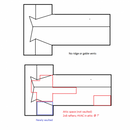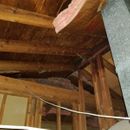Insulation (venting) questions
Southern Arizona (Zone 2-3); aiming for a modest R30. HVAC ducts are on the attic floor, but nothing else is.
So I bought a 1970s house without attic access, and I can’t say I recommend it. When we finally opened up access, we found a lovely layer of black on much of the OSB, beams, and rafters. Some of the OSB had been replaced, and the R19 FG batts that had once been shoved between the rafters were all over the attic floor–mostly in ineffective piles.
I now have two issues I need to deal with. First, we need to insulate a vaulted ceiling in the master bathroom, outlined in blue in the diagram I’ve attached (hopefully). Some of this room (about 3 rafter bays worth) has soffit vents, but there are no ridge vents and no gable vents. The rafters are 2×8 (7.5″ actual), and I was considering adding 2x2s to make 9″ of space–enough for R30 Rockwool batts (7.25″) and an air gap. Do I also need to vent the ridge? If I were to vent the ridge, wouldn’t I need to compensate for the lack of soffit vents in most of the rafter bays?
Second, I need to do something about the remaining attic problem. Because of the way the roof is set up (hopefully my diagram makes sense!) no vents reach the attic–no ridge vents, no gable vents, and few if any of the soffit vents make it up to the attic because almost the entire perimeter of the house is vaulted ceilings. Is my only option closed-cell foam? I hesitate to spray anything directly on the moldy OSB because we may want to replace a lot of it when it eventually comes time to redo the roof (which is currently only about 2 years old, so we don’t want to tear it out yet if we can help it).
Thank you for any guidance. Researching options has been overwhelming.
GBA Detail Library
A collection of one thousand construction details organized by climate and house part











Replies
HI code4fun -
1. before doing much of anything else, it's important to figure out why you have mold in your attic. You are in a dry and warm climate so where did the moisture come from. In addition to bulk water and air leakage, you should consider household sources of moisture (mainly related to occupant number and behavior) - see: https://www.greenbuildingadvisor.com/article/moisture-sources-relative-humidity-and-mold.
2. Don't worry about roof venting first; in your climate way more important to get the roof air control layer correct. Solve for that and roof venting is your backup plan for moisture management.
Peter
Thanks. It looks like the roof was actively leaking at some point, based on the water stains on some of the OSB. There are also some minor stains on patches of ceiling drywall. I know one stain is from where they ripped a pool heater off the roof without patching the shingles (we had that fixed after inspection), and other leaks appear to have been near chimneys. The current roof looks like it was done well near the chimneys, and those stains have not gotten any worse despite heavy rain and even snow this year--so I don't think there is still an active leak from above. If I had to guess, I'd say the roof is so new because it was failing, starting to noticeably leak, and they didn't have a choice but to redo it before selling. Perhaps the gradual failure of the roof was ongoing long enough to cause a mold problem in the attic?
We bought the house from a older couple who had had it for a long time. They had a habit of leaving the heat (gas furnace) and A/C off, from what we understand, which would increase the humidity, but it's still the desert. The indoor humidity for the year we've lived here sits at about 20-30% unless it is monsoon season (50-60%). The laundry is outdoors. There are fans in the bathrooms with showers in them. The kitchen is nowhere near the attic space. The bedrooms all have their original, leaky single-pane aluminum windows from the 70s, though the rest of the house was upgraded to dual pane in the 2000s. There are no can lights (or really any lights) in the ceilings. It's all wall sconces and lamps. The exterior doors leak like crazy, and there are two chimneys.
I'm not sure what else to check or change in terms of stopping further mold issues.
Is it possible that the mold is due to the way the attic is built and insulated itself? This house is made up of unvented vaulted ceilings and an unvented attic, all insulated with R19 batts. Everything I read says not to use batts for unvented setups because of moisture issues. I could install a gable and ridge vent for the attic, but at this point I assume the vaulted ceilings are just going to slowly rot until we replace the roof.
Hi again -
At this point, not sure how much more I can help from a distance. I recommend that you get a BPI-certified technician to conduct airtightness testing and evaluate your home/situation. It will be money well spent.
If you to to http://www.bpi.org, they have a zip code-driven locator of auditors.
Peter